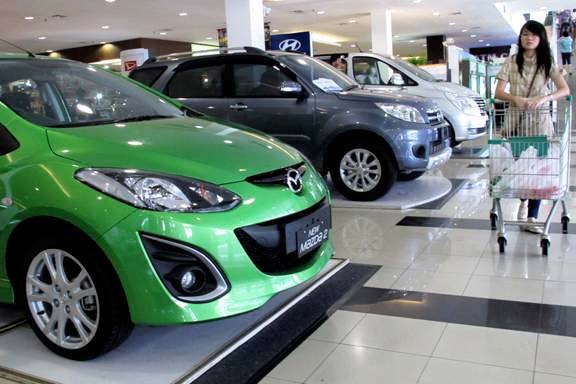Beyond The BRICs
Emerging markets have been a big theme at TTAC for the past few years, with our coverage going beyond the cursory articles on automotive developments in the BRIC countries. Our articles on places like North Africa and Indonesia aren’t always the most popular, but we keep an eye on them for a very important reason. These countries are the final frontier for growth in the automotive sector.
Boston Consulting Group released a report that urges auto makers to look beyond the BRICs, to a group of 88 countries that contain roughly 40 percent of the world’s population. Collectively, annual growth of 6 percent is expected, below India’s 10 percent, but on par with China and outpacing both Brazil and Russia.
Rather than cover all 88 nations, BCG identified the “Future 15” countries where car sales are expected to show strong increases in sales (Iran, Turkey, Saudi Arabia, the Ukraine, Indonesia, South Korea, Thailand, Malaysia, Taiwan, Mexico, Argentina, Colombia, Chile, South Africa and Algeria), as well as four regional areas that will serve not only as sales hot spots, but also as future locations for assembly plants, R&D and sourcing. Not surprisingly, these are based in North Africa, the ASEAN region, the Middle East and the Andean region in South America.
The need for specific regional strategies is a key theme in the report, with BCG devoting plenty of space to the need for product, financing and sourcing solutions that are best adapted to regional characteristics. Among their examples are the importance of offering a vehicle with a low tax burden in the Middle East, a tailor-made financing plan for Latin American consumers from Chevrolet and Renault’s North African assembly efforts for its Dacia brand.
One of the more interesting examples highlighted by the report was that of the ASEAN countries. Toyota is overwhelmingly dominant in Indonesia, its biggest market, and one possible reason is because of its ability to build products at an appropriate price-point that strongly resonate with local buyers. A side by side comparison between the Japanese market Sienta MPV and the Indonesian Avanza shows how this is done.
On the surface, the two seem indistinguishable, but under the skin, they are vastly different cars. The Sienta rides on a platform shared with the Yaris, while the Avanza uses a rugged, body-on-frame rear-drive layout with increased ground clearance, to handle Indonesia’s rougher roads and frequent flooding. Its powertrain and interior are much less advanced, and the Avanza has fewer creature comforts. But it’s built to a price, costing as much as $5,000 less than a Sienta, a fact that’s reflected in the slab-sided body panels, which are easier and cheaper to stamp. This kind of specialization is what’s allowed Toyota to capture 90 percent of Indonesia’s market, giving them an enormous head start in what is expected to be the next big place to sell cars.
ASEAN is not the only region where Toyota enjoys the top spot. The auto maker is leading slightly in volume in the Middle East, though second-place Kia is essentially equal in terms of market share. Chevrolet is regarded as the leader in the Andean belt, while Renault and Dacia are tops in North Africa. While Korean OEMs also have a strong showing, both Renault and Peugeot are strong in the Middle East and Africa, even as their efforts falter in Europe.
The common thread with all of this is an emerging middle class in regions where that notion did not exist. With prosperity on the rise, they are eager to attain greater mobility and freedom though an automobile of their own. Along with personal transportation comes the possibility of good jobs in assembly plants, sales and after-sales, logistics and other related industries. Renault and Dacia have begun to look to North Africa as a regional hub not only for the African market, but for the Middle East and even Europe. Nissan’s Datsun brand is one of the first to explicit target the “Beyond BRIC” countries, with stated aims to expand into Indonesia and Africa in the near future.
More by Derek Kreindler
Latest Car Reviews
Read moreLatest Product Reviews
Read moreRecent Comments
- Kjhkjlhkjhkljh kljhjkhjklhkjh I'd rather they have the old sweep gauges, the hhuuggee left to right speedometer from the 40's and 50's where the needle went from lefty to right like in my 1969 Nova
- Buickman I like it!
- JMII Hyundai Santa Cruz, which doesn't do "truck" things as well as the Maverick does.How so? I see this repeated often with no reference to exactly what it does better.As a Santa Cruz owner the only things the Mav does better is price on lower trims and fuel economy with the hybrid. The Mav's bed is a bit bigger but only when the SC has the roll-top bed cover, without this they are the same size. The Mav has an off road package and a towing package the SC lacks but these are just some parts differences. And even with the tow package the Hyundai is rated to tow 1,000lbs more then the Ford. The SC now has XRT trim that beefs up the looks if your into the off-roader vibe. As both vehicles are soft-roaders neither are rock crawling just because of some extra bits Ford tacked on.I'm still loving my SC (at 9k in mileage). I don't see any advantages to the Ford when you are looking at the medium to top end trims of both vehicles. If you want to save money and gas then the Ford becomes the right choice. You will get a cheaper interior but many are fine with this, especially if don't like the all touch controls on the SC. However this has been changed in the '25 models in which buttons and knobs have returned.
- Analoggrotto I'd feel proper silly staring at an LCD pretending to be real gauges.
- Gray gm should hang their wimpy logo on a strip mall next to Saul Goodman's office.


































Comments
Join the conversation
Iran has a solid manufacturing and R&D base in place already. They were producing nearly 1M cars last time I checked (long time ago).
There are those who would have you spell BRICs as BRICS - mostly the South African government. However, all is not well for the car manufacturing industry in the lower-case 's' in BRICs. BMW has stopped "all future plans" to expand in South Africa after a four-week strike caused a huge drop in production and profits. http://www.bbc.co.uk/news/business-24367675